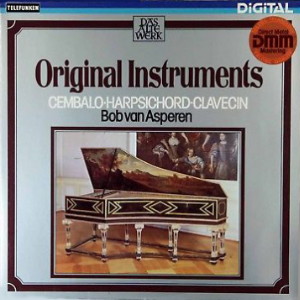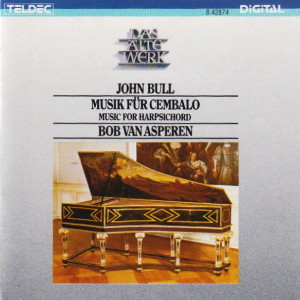 |
1 LP -
Telefunken 6.42874 AZ (p) 1983
|
 |
| 1 CD -
Teldec 8.42874 ZK (c) 1984 |
|
| ORIGINALINSTRUMENTE - Cembalo |
|
|
|
|
|
|
|
| John Bull
(1562-1628) |
In
Nomine IX |
|
6' 25" |
A1 |
|
The
King's Hunt |
|
3' 46" |
A2 |
|
Queen
Elizabeth's Chromatic Pavan and
Galliard |
|
10' 03" |
|
|
-
Chromatic Pavan |
6' 43" |
|
A3 |
|
-
Chromatic Galliard |
3' 23" |
|
A4 |
|
Dutch
Dance |
|
1' 22" |
A5 |
|
Fantasia
XII |
|
6' 13" |
A6 |
|
Fantastic
Pavan and Galiarda |
|
9' 00" |
|
|
-
Fantastic Pavan |
6' 44" |
|
B1 |
|
-
Galiarda |
2' 16" |
|
B2 |
|
In
Nomine XII |
|
3' 39" |
B3 |
|
Germanin's
Alman |
|
2' 32" |
B4 |
|
Fantasia
X |
|
4' 41" |
B5 |
|
Canon
in subdiapente, two parts in one
with a running base ad placitum |
|
6' 06" |
B6 |
|
Doctor
Bull's My Selfe |
|
0' 47" |
B7 |
|
|
|
|
|
| Bob van ASPEREN,
Cembalo (Ruckers, 1624) |
|
|
|
|
|
Luogo
e data di registrazione |
|
-
|
|
|
Registrazione:
live / studio |
|
studio |
|
|
Recording
Supervision
|
|
-
|
|
|
Edizione LP |
|
TELEFUNKEN
- 6.42874 AZ - (1 LP - durata 55'
39") - (p) 1983 - Digitale |
|
|
Originale LP
|
|
- |
|
|
Prima Edizione CD |
|
TELDEC
- 8.42874 ZK - (1 CD - durata 55'
39") - (c) 1984 - DDD
|
|
|
Note |
|
-
|
|
|
|
|
Cryptograms,
lamentations,
dances,
satires,
musical
souvenirs,
naturalistic
and
surrealistic
fantasies,
fatalistic
canons..., all
this
paradoxical
wealth is
presented to
us in the
œuvre of
Doctor John
Bull, whom we
may regard
certainly as
the most
intriguing of
the English
virginalists.
As, in his
most
substantial
works, we meet
with
tendencies
which almost
evoke the
metaphysical,
it does not
necessarily
surprise that
this "musical
doctor", born
in
Radnorshire,
Wales, took a
special
interest in
the occult
sciences -
like so many
other artists
and scholars
those days -
having several
friends in
hermetic
circles and
choosing to
have his
portrait
painted,
flanked by
alchemistic
symbols. As an
organist of
the Chapel
Royal, Bull’s
place in the
hierarchy
surrounding
Elizabeth I is
unclear.
In any case he
was not one
ofthe Queen’s
private
musicians as
has generally
been assumed.
His services
must have been
important
nonetheless,
as he was
recalled to
London by
Elizabeth in
several
letters during
the course of
a sick(?) -
leave passed
on the
continent; he
also received
her special
permission to
give his
lectures in
English (as he
obviously did
not speak
Latin
fluently) and
his name stood
at the head of
the list of
the Gentlemen
of the Chapel
Royal at the
Queen’s
funeral.
However, in
connection
with a serious
scandal, in
which he
becomes
involved in
1613, to avoid
prosecution,
he has to
leave his home
country
hurriedly and
seeks safety
in the South
Netherlands.
As a catholic
refugee he
ends up
inBrussels,
entering the
service of
Austrian
Archduke
Albert
(governor ot
the Spanish
Netherlands)
to which court
his friend and
colleague,
virginalist
Peter Philips,
had preceded
him before.
Within a year
he was
dismissed
though,
through
pressure from
a furious
James I,
receiving
nevertheless
private
gratuities
from the
Archduke for
three years
thereafter...
The 52-year
old man now
presented a
request to the
Mayor of
Antwerp as a
result of
which he
received alms
to relieve his
poverty, and
was appointed
as an organist
at Antwerp
cathedral, a
position which
he held until
his death.
By what
capricious,
sometimes
almost
apocalyptic
invention,
coupled with
learned
austerity,
this keyboard
fanatic was
driven, (upon
being
challenged by
a musician to
add a new part
to a
composition,
he added
fourty!) we
may discover
when looking
upon him in
the
perspective of
his
contemporaries
Byrd,
Sweelinck and
Philips, and
most
importantly of
his
predecessors;
Preston,
Farrant and
Tallis.
Possibly we
should not
underrate
either the
influence of
l6th century
composer
William
Blitheman,
whose epitaph
once contained
the following
lines:
In
Nomine IX
Bull's
most capital
composition, in
the form, as it
were, of a
crossword
puzzle, brings
the cantus
firmus, the
antiphon "Gloria
tibi trinitas",
in the bass. The
remarkable 11/4
meter is formed
from two groups
of four and one
group of three
units.
The
King's Hunt
A rare
example of
"painting from
nature" in
keyboard music,
evoking the
royal hunt of
James I (after
1603).
Queen
Elizabeth's
Chromatic
Pavan and
Galliard
Was this
perhaps written
as a "tombeau"
for the Virgin
Queen? At the
end of the Pavan
we seem to hear
the carillon (in
a major key!) of
high funeral
bells...
Dutch
Dance
The
title might
explain
itself...
Fantasia
XII
Contrasting
fragments are
accumulated in
an improvisatory
style.
Fantastic
Pavan and
Galiarda
An
apocalyptic
vision of this
classic pair of
dances.
In
Nomine XII
A more
diminutive
rendering of
this form than
"In nomine IX",
marked by an
aleatory effect
of bell-like
syncopations.
Germain's
Alman
Suggests
a connection to
the Court of St.
Germain in
Paris. during
Bull's
continental
journey in 1601.
Fantasia
X
This
meditative
bicinium later
develops a
curious
chromatic bass
ostinato.
Canon
in
subdiapente,
two parts in
one with a
running base
ad placitum
In this
painfully
worked-out
"fugue" the two
upper voices
pursue one
another at the
fifth, over the
continuous
accompaniment of
a so-called
running bass.
The
harpsichord
used for this
recording had
remained at
least since
the eighteenth
century at the
castle of
Condé-en-Brie
(Aisne,
France), and
is now beeing
kept in the
Museum
Unterlinden at
Colmar
(Alsace). It
must have been
built by Hans
Ruckers the
Younger in
1624 as a
so-called
transposing
instrument,
with two
keyboards and
two sets of
strings (one
eight-foot and
one four-foot
choir), a
disposition
which may be
regarded as
representative
for a
harpsichord
from Bull's
time.
In the course
of several
modifications
during the
seventeenth
and eighteenth
centuries it
obtained
amongst other
things a
larger
keyboard
compass
(although the
case was not
enlarged!),
and a second
eight-foot
register was
added; also
the
"oldfashioned"
transposition
system was
normalised and
the instrument
received its
present
elaborate
baroque stand
and
decoration.
(Although this
now enriched
and more
"expressive"
harpsichord
type was
caracteristic
for the later
period,
especially in
France, it
existed
obviously
already in the
early 17th
century as
well, as
several
iconographic
documents
prove.)
The
instruments
recent
restauration,
finally, by
Christopher
Clarke and the
atelier "Les
Tempéraments
Inégaux",
Paris, permits
us to verify
also today the
resonance and
speaking
quality for
which the old
Flemish
harpsichord
building was
so highly
prized.
A visual
complement to
the
instruments
eloquence
presents
itself in the
striking, also
younger
painting
within the
lid: in an
Arcadian
landscape,
king Midas
judges the
contest
between Apollo
and Pan...
Bob
van Asperen
|
|
|

